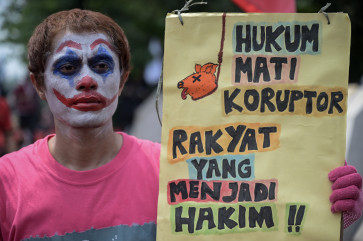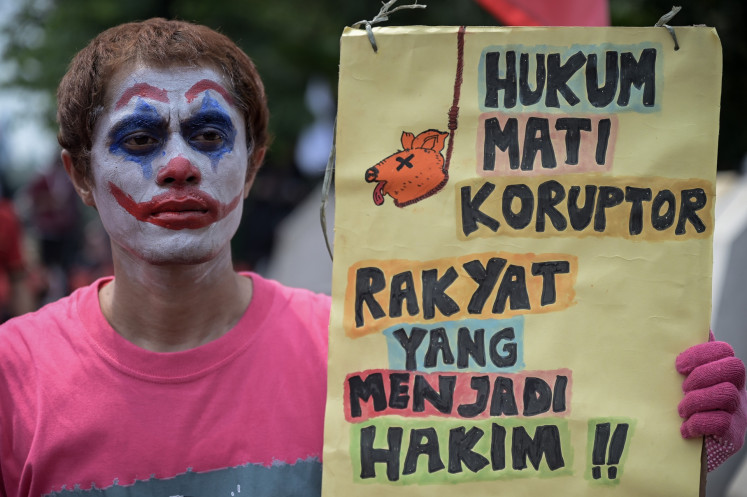Popular Reads
Top Results
Can't find what you're looking for?
View all search resultsPopular Reads
Top Results
Can't find what you're looking for?
View all search resultsRI in for huge power supply
Indonesia will see a massive increase in power supply this year thanks to 19 coal-fired power plants, with a combined operational capacity of 3,620 megawatts (MW)
Change text size
Gift Premium Articles
to Anyone
I
ndonesia will see a massive increase in power supply this year thanks to 19 coal-fired power plants, with a combined operational capacity of 3,620 megawatts (MW).
This year’s power supply, if materialized, will be the biggest since the 1998 financial crisis, according to the Energy and Mineral Resources Ministry.
The plants are part of the delayed first phase of the 10,000 MW program, launched in 2006, to fast track the construction of power plants.
Energy and Mineral Resources Ministry’s director general for electricity Jarman Sudimo said on Wednesday that some of plants were due to be completed last year.
“However, due to some technical problems, the trial period to test their operations had to be extended, causing a delay in the commencement of their operations,” said Jarman.
Some of the problems faced during the trial included failure to meet expected production capacity as well as unplanned shutdowns, according to Jarman.
Despite the issues, Jarman said that the government remained upbeat that most of the projects, particularly plants such as 3x350-MW Pelabuhan Ratu in West Java and 2x315-MW Pacitan plant in East Java would be completed in the first quarter of this year.
In the first half of the year the government expected the combined capacity of the online power plants to be around 1,400 MW, he said.
“There are many plants with low capacities. So I do not foresee their completion facing any trouble,” he said.
State power company PT Perusahaan Listrik Negara (PLN) has warned the government to not rush into operating the plants as the company would first examine their reliability.
PLN president director Nur Pamudji said the company was focusing on the sustainability of the plants before approving their operation.
He said it would be useless if a plant had a big capacity, but failed to supply the power efficiently and uninterrupted.
Indonesia, whose economy accounts for 40 percent of Southeast Asia, struggles with protracted
infrastructure capacity problems, including power plants.
The capacity shortfall, according to economists, has hindered the country’s economy from growing over 6 percent.
PLN’s director of planning and risk management Murtaqi Syamsuddin said Indonesia’s annual electricity consumption would rise by 9.9 percent in line with the annual economic growth of 6 percent.
“This means the country needs additional power of 4,500 MW per year,” he said.
“It also needs additional funds of Rp 80 trillion (US$8.3 billion) to support this. PLN’s financial coverage will only be around Rp 40 to 45 trillion,” he said.
In 2013, PLN would invest around Rp 64.9 trillion, up from Rp 50 trillion in 2011. Out of the total investment, around Rp 20.8 trillion will be from loans and Rp 18.2 trillion from the firm’s internal funds.
In addition to the 3,620 MW projects initiated by PLN this year, the government also expects another 1,000 MW of additional supply from private companies under the independent power producer (IPP) scheme, such as the Poso plant in Central Sulawesi.
This year, the government estimates a 9-percent increase in the power plant installed capacity to 47,966 MW compared with last year. However, the supply will remain insufficient to support expansion in the manufacturing sector.
According to PLN, the peak consumption in Java-Bali alone has added to another 20,500 MW, while Sumatra comes second with 5,000 MW. The eastern part of Indonesia including Kalimantan has a peak production of around 3,000 MW.
Hanan Nugroho, a senior planner with the National Development Planning Agency, currently a research fellow at Harvard University for energy development, said that the country’s target to increase power supply by 3,500 to 4,500 MW per year is still small when compared to other countries such as China or Malaysia.
“The real problem of developing more plants in Indonesia is quality control,” he said.
Furthermore, the government must map out the whole plan for the construction of power plants, from the locations to land acquisitions, to avoid any bureaucracy issues that would postpone the projects, Hanan said.
All projects under the first 10,000 program are initially scheduled for completion in 2011. However, due to delays the government aims to complete construction by 2014.
The National Energy Council (DEN) has warned that the long-term economic development plan needs to be supported with additional energy supplies to meet demand, which is expected to increase threefold by 2030.










